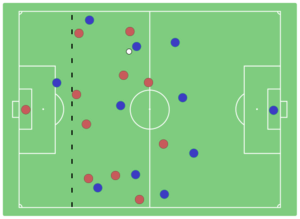Offside (bandy) facts for kids
Offside is an important rule in bandy, a sport played on ice with sticks and a ball. It helps make the game fair and exciting. The rule stops players from getting too close to the opponent's goal before the ball gets there. If a player is in an "offside position" when a teammate passes the ball, they can't join the play. If they do, it's called an "offside offence." Any goals scored from an offside offence won't count.
The offside rules in bandy are very similar to those in soccer. They are part of the official Bandy Playing Rules, set by the Federation of International Bandy (FIB).
How Offside Works
Understanding offside involves three main parts: being in an offside position, committing an offside offence, and the penalty for it.
Offside Position
A player is in an offside position if three things are true:
- They are in the opponent's half of the rink (the playing area).
- They are closer to the opponent's goal line than the ball.
- There are fewer than two opposing players (including the goalkeeper) between them and the opponent's goal line.
If a player is level with or behind the ball, they are never in an offside position. This means they cannot be called for an offside offence.
Offside Offence
An offside position isn't always an offence. An offside offence happens if a player in an offside position:
- Receives the ball from a teammate.
- Gets in the way of the game or an opponent.
- Gains an unfair advantage from being in that position.
The referee judges this at the exact moment the ball is passed by a teammate, not when the player receives it. However, the referee might wait a moment to see how the play develops. If a player is offside but doesn't get involved in the game or bother an opponent, it's not an offence.
The offside rule also applies during special restarts like free-strokes, penalty shots, face-offs, and goal-throws. If a player receives the ball from a teammate while offside, it's still an offence, even if an opponent touches the ball on its way. However, if a player receives the ball directly from an opponent, it's not offside.
Offside Penalty
When the game is stopped because of an offside offence, the other team (the defending team) gets a free-stroke. This free-stroke is taken from where the offside player was when the ball was passed to them.



